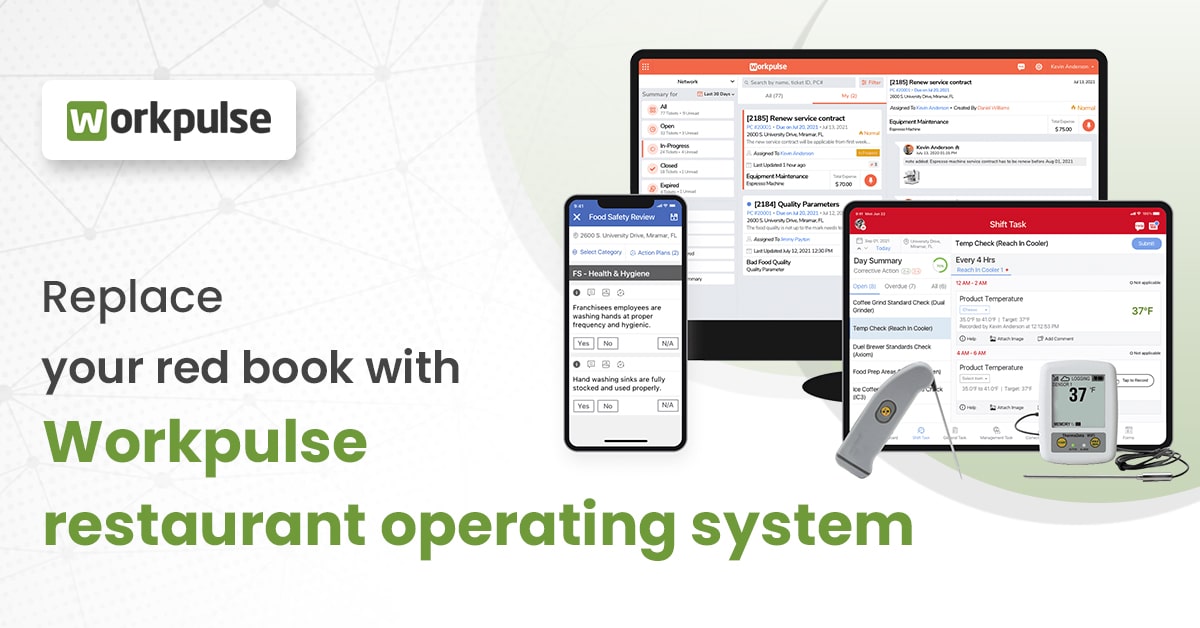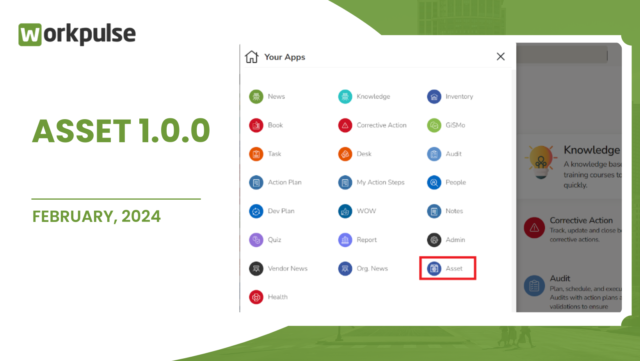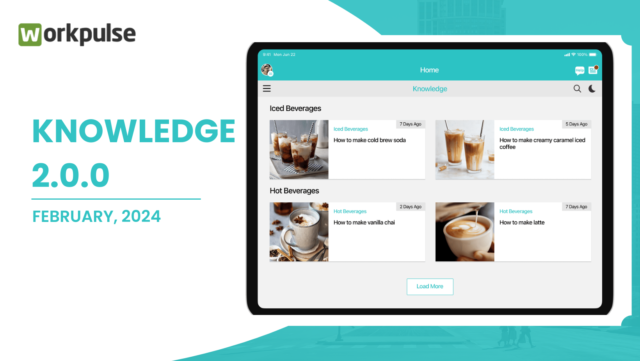In the fast-paced and ever-evolving world of the restaurant industry, staying ahead of the competition while maintaining efficient operations is a constant challenge. The days of relying solely on traditional methods, such as the trusty red book, are gradually becoming a thing of the past. The rise of technology and the demands of modern guests require a more dynamic and comprehensive approach to managing restaurant operations. This is where the Workpulse digital restaurant operating system (rOS) steps in, offering a transformative solution that revolutionizes how restaurants operate, communicate, and thrive in today’s competitive landscape. In this blog, we’ll delve into the reasons why it’s not just a choice but a necessity to replace your red book with the Workpulse rOS. Let’s explore how this innovative platform can propel your restaurant into a new era of efficiency, communication, and success.
What is red book and why are they being replaced?
A “red book” in the context of restaurants typically refers to a physical logbook or journal that is traditionally used to record important information, such as shift schedules, maintenance tasks, incidents, customer feedback, and other relevant operational details. This manual record-keeping practice has been a common method for communication and documentation within the restaurant industry. The name “red book” often originates from the color of the book’s cover, although the actual color can vary.
Red books have served as a means of communication between different shifts, staff members, and management, allowing for the sharing of critical information about daily operations and any notable occurrences. However, with the advancement of technology and the need for real-time communication and data analysis, many restaurants are transitioning from these physical logbooks to digital solutions like restaurant operating systems.
Restaurant operating systems like Workpulse rOS offer a more efficient and comprehensive way of managing restaurant operations. They provide digital platforms that streamline communication, task management, feedback handling, compliance tracking, and other essential functions, all accessible in real time from various devices. This transition from traditional red books to digital systems reflects the industry’s need to embrace technology for improved efficiency, accuracy, and overall operational excellence.
Broader differences between a red book and a digital restaurant operating system
A red book and a digital restaurant operating system (rOS) are both tools used to manage restaurant operations, but they differ significantly in their features, capabilities, and approach to handling tasks and communication. Here’s a comparison of the two:
Red Book:
- Physical Format: A red book is a physical logbook or journal typically kept on-site at the restaurant. It involves writing down information by hand.
- Manual Communication: Communication in a red book involves writing notes, instructions, and feedback by hand. It can be time-consuming and may not be real-time.
- Limited Accessibility: A red book is limited to the physical location of the restaurant. It may not be accessible remotely, making it challenging for off-site managers to stay updated.
- Limited Data Analysis: Information recorded in a red book may be difficult to analyze comprehensively, as it requires manually going through pages to gather insights.
- Task Management: Task assignment and tracking might be less efficient in a red book, as it relies on manual entry and updates.
- Feedback Handling: Recording and addressing customer feedback might be less organized, potentially leading to delays in resolution.
Digital Restaurant Operating System (rOS):
- Digital Format: A digital rOS is a software platform accessible via smartphones, tablets, and computers. It involves electronic data entry and management.
- Automated Communication: A rOS allows real-time communication through digital messages, notifications, and alerts, streamlining communication between staff members and shifts.
- Remote Accessibility: A rOS can be accessed remotely, allowing managers and owners to stay updated and manage operations from anywhere.
- Comprehensive Data Analysis: A rOS collects and analyzes data, providing insights into various aspects of operations, from sales trends to compliance adherence.
- Efficient Task Management: Task assignment and tracking are streamlined in a rOS, with features like task creation, assignment, reminders, and progress tracking.
- Feedback Handling: rOS provides structured channels for handling customer feedback, ensuring timely responses and resolution.
- Compliance Tracking: A rOS often includes modules for tracking compliance with brand standards, food safety regulations, and more, simplifying audit processes.
- Integration: A rOS may integrate with other systems such as POS, inventory management, and customer engagement tools, creating a unified ecosystem.
How restaurant red books are being replaced with digital restaurant operating system
In the rapidly evolving landscape of the restaurant industry, one significant transformation is replacing the traditional red books with digital restaurant operating systems (rOS). These innovative systems are revolutionizing how restaurants manage their operations, streamline processes, and elevate the guest experience. Let’s explore how these digital solutions are reshaping the way restaurants operate and why they are becoming an indispensable tool for modern eateries.
#1: From Manual to Digital: Streamlining Operations
Traditional red books, although reliable, are often prone to inefficiencies and human errors. In contrast, digital rOS offers a comprehensive platform that centralizes various operational aspects. From task assignments to inventory management, staff scheduling to compliance tracking, everything is seamlessly integrated. This transition from manual to digital not only saves time but also enhances accuracy and efficiency.
#2: Real-time Insights for Informed Decisions
Red books involve manual entry, making it challenging to access real-time data and insights. With digital rOS, restaurant owners and managers can instantly access crucial information. Analytics and reporting tools provide valuable insights into sales trends, customer preferences, and operational performance. This empowers decision-makers to make informed choices, adapt strategies, and seize growth opportunities.
#3: Enhanced Communication and Collaboration
Digital rOS breaks down communication barriers among staff members, from front-of-house to back-of-house. Notes, alerts, and notifications can be shared instantly, improving collaboration and ensuring everyone is on the same page. This real-time communication enhances guest service, minimizes misunderstandings, and fosters a more efficient workflow.
#4: Compliance Made Easier
Maintaining compliance with health and safety regulations, food standards, and brand protocols is crucial for any restaurant. Digital rOS simplifies compliance management by automating audits, checklists, and record-keeping. Regular inspections, once a cumbersome task, are now streamlined, ensuring that restaurants remain compliant and prepared for unexpected visits.
#5: Guest Experience and Feedback
Gone are the days when guest feedback required flipping through the red book’s pages. Digital rOS offers modules dedicated to capturing guest feedback, complaints, and reviews. This real-time feedback loop enables swift responses, addressing concerns promptly, and turning dissatisfied guests into loyal patrons.
#6: Staff Training and Development
Training manuals tucked within red books are now transformed into interactive modules within digital rOS. Training schedules, materials, and assessments can be managed digitally, allowing for standardized and efficient staff training. This leads to consistent service quality and increased employee engagement.
#7: Adaptation to Industry Trends
The restaurant industry is dynamic, with trends changing rapidly. Digital rOS can be updated seamlessly to accommodate new trends, menu changes, or operational requirements. This adaptability ensures that restaurants stay relevant and responsive to evolving customer preferences.
The shift from red books to digital restaurant operating systems marks a significant advancement in how restaurants manage their operations. These systems not only replace manual processes with efficient digital workflows but also empower restaurant owners and managers to adapt, innovate, and deliver exceptional guest experiences. As the industry continues to evolve, embracing digital rOS is becoming less of a choice and more of a necessity for restaurants that aim to stay competitive and thrive in the modern dining landscape.
How Workpulse rOS is the right replacement for your red book
Workpulse rOS (Restaurant Operating System) offers a comprehensive solution that addresses the shortcomings of traditional red books and empowers restaurants to improve performance, visibility, and excel in inspections. Here’s how Workpulse rOS can help:
#1: Enhanced Communication and Visibility
- Real-Time Communication: Workpulse rOS provides a digital platform for real-time communication among staff members, enabling them to share important updates, tasks, and feedback instantly.
- Centralized Dashboard: The system offers a centralized dashboard that displays all tasks, assignments, and updates, ensuring that nothing is missed.
#2: Efficient Task Management
- Task Assignment and Tracking: Workpulse rOS streamlines task management with features like task creation, assignment, due dates, and progress tracking, eliminating manual errors and improving accountability.
- Automated Reminders: Automated reminders ensure that tasks are completed on time, reducing the risk of forgotten tasks.
#3: Compliance and Audit Readiness
- Digital Audit Management: Workpulse rOS includes audit management features that allow restaurants to create, assign, and track audits efficiently. This ensures that compliance with brand standards and regulations is consistently met.
- Documentation and Proof: Restaurants can attach photos, videos, and documents as proof of compliance, making it easy to provide evidence during inspections.
#4: Customer Feedback and Resolution
- Guest Recovery & Retention Module: Workpulse rOS provides a module for handling customer feedback and complaints. Restaurants can assign guest complaints to the right personnel for quick resolution, enhancing customer satisfaction.
- Professional Responses: Templates for responses ensure that customer complaints are addressed professionally and consistently.
#5: Data Analysis and Reporting
- Comprehensive Insights: Workpulse rOS offers analytics and reporting features that allow restaurants to analyze data from various aspects of their operations, enabling informed decision-making.
- Trend Identification: Analyzing data helps identify trends, enabling restaurants to adapt their strategies based on customer preferences and operational performance.
#6: Remote Accessibility and Monitoring
- Cloud-Based Access: Workpulse rOS can be accessed remotely, enabling managers and owners to monitor operations, review reports, and address issues even when not on-site.
#7: Integration with Other Tools
- Unified Ecosystem: Workpulse rOS can integrate with other systems like POS, inventory management, and customer engagement tools, creating a seamless operational ecosystem.
By using Workpulse rOS, restaurants can transcend the limitations of traditional red books and embrace a modern, digital solution that not only improves operational efficiency but also enhances guest experience. With features tailored to meet the demands of the restaurant industry, Workpulse rOS empowers restaurants to ace inspections, meet customer expectations, and thrive in a competitive landscape.
Break free from your red book woes with Workpulse rOS
In the world of ever-evolving restaurant operations, it’s time to bid farewell to the limitations of the traditional red book and embrace the future with Workpulse rOS. The challenges that have long haunted restaurant owners and managers – from communication gaps to compliance worries – can now be confidently left behind. Workpulse rOS emerges as the ultimate solution, empowering restaurants to break free from the constraints of the past.
With Workpulse rOS, the era of manual record-keeping, scattered communication, and tedious compliance management is replaced by a streamlined, digital ecosystem that enhances efficiency, accountability, and overall excellence. The transition from red books to Workpulse rOS signifies a transformation towards a modern and dynamic approach to restaurant management.
As restaurants adopt Workpulse rOS, they open the door to a realm where communication flows seamlessly, tasks are managed effortlessly, compliance becomes a certainty, and customer satisfaction is a top priority. The red book woes become a thing of the past as restaurant owners and managers gain the tools they need to not only survive but thrive in a competitive industry.
The choice is clear – break free from the confinement of outdated processes and embrace the revolutionary capabilities of Workpulse rOS. The journey towards operational excellence and guest satisfaction starts here, promising a future where challenges are met with confidence, and success is defined by innovation and adaptability. Welcome to a new era of restaurant management with Workpulse rOS. Schedule your demo today.




